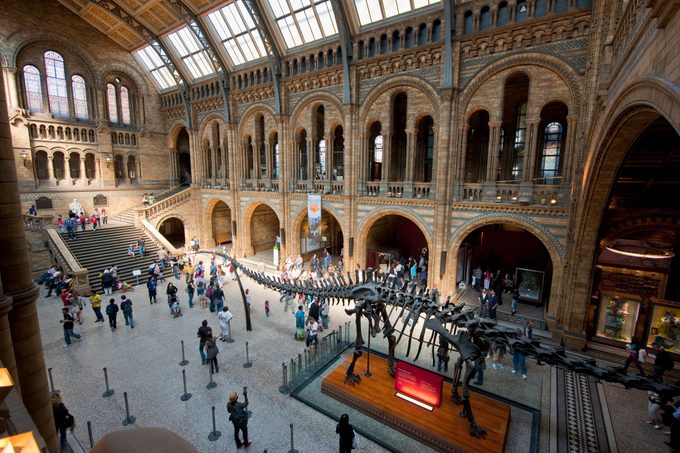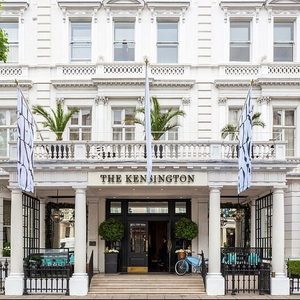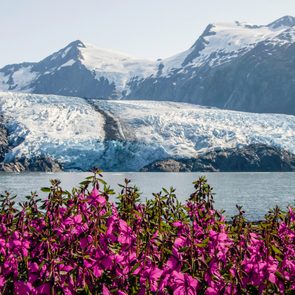The Best Time to Visit London, According to a Local
Updated: Mar. 14, 2024

London is one of the most popular tourist destinations in the world. To make the most of it, you want to get your timing right.
Our editors and experts handpick every product we feature. We may earn a commission from your purchases.Learn more.
King Charles III’s coronation has once again put London in the spotlight. But even when there’s no new king being crowned, the British capital is a bucket-list destination for many. And—no surprise here—it can get pretty crowded at times as a result. Of course, the fact that it’s popular shouldn’t put you off from visiting London. And neither should the city’s bad reputation when it comes to weather. Smart travelers know it’s all about finding the best time to visit London and then making every minute count!
As a local for more than five years, I can say without a doubt that London deserves its spot on the list of best places to travel, even if it’s not on the list of the cheapest places to travel. And just like when you are looking for the best time to visit Italy or any other destination, it’s all about timing your trip right. Whether your main goal is to time your stay to catch some of the best events or find a shoulder season to avoid the crowds and save some money while still having lots of fun, here’s everything you need to know about the pros and cons of the different travel seasons—and what to do in London once you’ve arrived.
Get Reader’s Digest’s Read Up newsletter for more travel, tech, humor, cleaning and fun facts all week long.
What is the best month to go to London?
Peak season in London is April to September as well as December, according to Visit Britain—with July, August and the Christmas period earning the distinction as the busiest times of the year. Want to experience the city in full bloom? April is your best bet for seeing cherry blossoms in all their glory (head to Greenwich, Hyde Park or another of the royal parks). And the Chelsea Flower Show, held every May on the grounds of the Royal Hospital Chelsea, welcomes more than 150,000 visitors, including members of the royal family. July and August can be crowded and hotter, but they come with added perks, such as open rooftop terraces, music festivals like the BST Hyde Park (P!nk and Bruce Springsteen are this year’s headliners), the Wimbledon Championships and open-air cinemas (some of which are on boats!).
For sightseeing, I find the months of June and September are the best times to visit London, as you can still enjoy the summer weather but queues are slightly shorter. If you love Christmas markets or want to see the festive lights and New Year’s Eve fireworks, December is the obvious choice. (Bear in mind you need a ticket for the official fireworks display, so plan ahead.)
What time of year is cheapest to visit London?
Less than a fifth of all visitors to London arrive in the first three months of the year, making January to March the best time to visit London for those who want to avoid the lines and save money. As this period is considered off-season in the United Kingdom, it is also generally the best time to book a flight (have a look at budget airlines to save even more!) and the best time to book a hotel, with many of the latter offering special deals to fill their rooms. Just make sure your trip does not coincide with the school holidays in mid-February.
Love shopping? London traditionally rings in the new year with massive sales, so pencil in some extra time to check out Oxford Street, the fancy boutiques in Mayfair and Covent Garden’s trendy shops. If fall travel is more your cup of tea, you might want to plan your visit for October or November.
What are the rainy months in London?
Gray skies, nonstop rain? London has a bit of a reputation when it comes to bad weather—a fact you might want to consider when making your packing list. However, unless you are really unlucky, it’s very unlikely you will spend your entire vacation hiding from the elements. London has between 11 to 15 rainy days every month of the year. The winter months are the wettest, topping out in December with 3.3 inches of rain, while March is the driest with 2.2 inches.
The good news is, it hardly ever rains an entire day. Most showers are brief and more drizzle than downpour, which is why many locals don’t even bother carrying an umbrella. Short sprinkles are the perfect excuse to pop into a pub for a pint, check out one of the many museums and galleries, see a musical matinee in the West End or treat yourself to afternoon tea at legendary department store Harrods.
How many days in London is enough?
Once you’ve figured out the best time to visit London, how many days should you pencil in? While the average tourist stays for 4.84 nights, according to official statistics, the answer ultimately comes down to the number of vacation days you have, your budget and also where in the United States you are traveling from. After all, the longer the flight, the longer you’ll want your trip to be to make it count. The flight time from New York is seven hours, while Los Angeles is 10 hours and 30 minutes away. The time difference (five to eight hours) is another factor to consider as you won’t want to be jet-lagged throughout your entire stay.
Last but not least, the ideal amount of time for a London visit depends on your travel style: Quick trips of about three nights will allow you to tick the most important sights off your bucket list. If you want to explore different neighborhoods and add some hidden gems, however, I’d definitely recommend adding three to four extra nights.
What to do in London
“When a man is tired of London, he is tired of life,” said British writer Samuel Johnson in 1777—and for most locals, this still applies today. So, what should you do in London if you’re a first-timer?
Landmarks
Obviously, the classic landmarks are a must. Use this as your checklist when devising your itinerary:
- Big Ben (currently closed for visitors, but you can still take a selfie outside)
- Westminster Abbey (busiest in the mornings, so it’s best to visit after lunch or book a time slot)
- Buckingham Palace (catch the Changing the Guard ceremony at 11 a.m. on Mondays, Wednesdays, Fridays and Sundays, or daily in summer)
- The London Eye (buy timed tickets online to save time and money)
- The Tower of London (home to the crown jewels, which will be presented in a new, historic exhibit beginning at the end of May)
- The Tower Bridge
- St. Paul’s Cathedral
Museums

Love museums? London’s number one attraction, the Natural History Museum, is free of charge. The same goes for numbers two and three on the list: the British Museum, home to the Rosetta Stone and other historic artifacts, and the Tate Modern, showing works by Marcel Duchamp, Jackson Pollock, Andy Warhol and more.
Personally, I am a massive fan of the Saatchi Gallery, where past exhibitions include ones on street art, the heydays of rave and Bob Marley, and the 180 Studios, for video installations, such as its current one highlighting the work of Gabriel Moses. The new BBC Earth Experience narrated by David Attenborough also promises to be a breathtaking, 360-degree digital journey.
Theater and music
Theater fan? Tour the home of Shakespeare, the Globe Theatre, or catch a play. For musicals, head to the West End, where cheap, day-of tickets are available on the TodayTix app or at ticket booths around Leicester Square. Camden Town, on the other hand, is best for live music. For something new and different, check out ABBA Voyage, a “concert” featuring holograms of the beloved Swedish quartet.
Dining
If you’re a foodie, you can literally eat your way around the world in London. Some of the current hotspots include: Sachi, a must-try new sushi restaurant; Edit, which celebrates zero-waste cooking; and Kapara, an Israeli-inspired restaurant in Soho. Cahoots, located in a retired tube station a stone’s throw from Carnaby Street, is a fun and immersive bar experience you don’t want to miss—expect 1940s-flair, creative cocktails with names like “Winston Churchill” and “Judy Garland,” and live music. For drinks with London at your feet, head to Gong on the 52nd floor of The Shard for stellar views of the city. (Bonus: It’s popular with celebrities and members of the royal family.)
Places to stay in London
Many first-time visitors underestimate the size of London and end up spending a significant part of their vacation on tubes (aka the subway), buses and trains to and from their hotel and in between the sights. So, to avoid wasting time, I’d recommend choosing your neighborhood wisely. (Factoring in-town travel into your budget is a must when traveling cheap.)
If you’ve never been to London, Westminster makes an excellent base, with many of the main landmarks—such as Big Ben, the Houses of Parliament, Westminster Abbey, the London Eye and Buckingham Palace—right at your doorstep. Have a look at The Guardsman, The Resident Victoria, The Westminster London and Conrad London St. James. Love museums, parks and gardens? Kensington/South Kensington is home to the Natural History Museum (great for kids!), as well as the Science Museum and the Victoria & Albert Museum. Hyde Park and Kensington Gardens are also close by. The Kensington, The Resident Kensington, Park Grand London Kensington and London Lodge Hotel are all in prime locations.
Soho is London’s entertainment hub, with tons of restaurants, clubs, bars and a buzzing art and LGBTQ+ scene. Base yourself here if you want to explore the West End theaters and London’s party scene, while also being in walking distance to many of the must-see sights. The Resident Soho, The Soho Hotel and Mimi’s Hotel Soho have rave reviews on TripAdvisor.
And then there’s Shoreditch in East London, the trendy and slightly edgy home of London’s hipster crowd. If you have a weak spot for street art, outdoor markets, vintage shopping, nightlife and vegan food, you will fit right in. The Hoxton, citizenM London Shoreditch and The Z Hotel Shoreditch perfectly reflect the vibe.
Book your visit
Sources:
- Visit Britain: “2019 Inbound Data”
- Tracy Halliwell, Director of Tourism, Conventions & Major Events for London
- Statista: “Average length of overseas tourist visits to London in 2019, by purpose of trip”

























